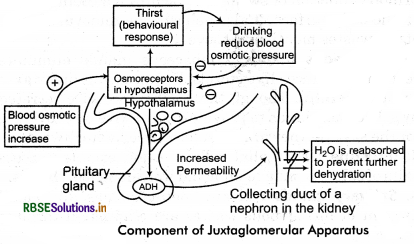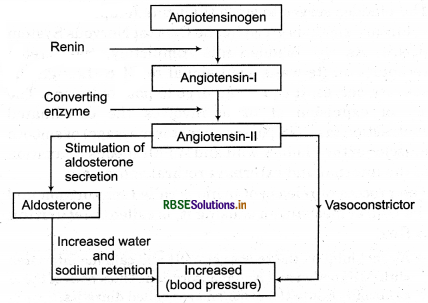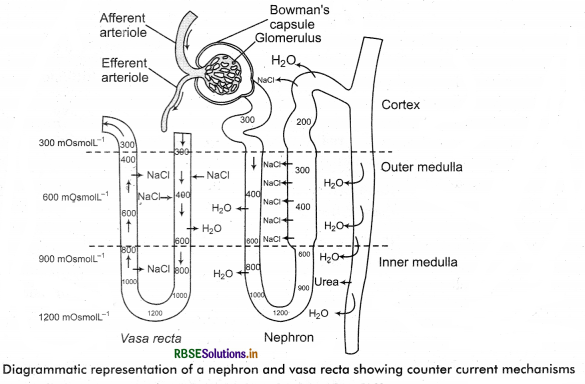RBSE Solutions for Class 11 Biology Chapter 19 Excretory Products and their Elimination
Rajasthan Board RBSE Solutions for Class 11 Biology Chapter 19 Excretory Products and their Elimination Textbook Exercise Questions and Answers.
RBSE Class 11 Biology Solutions Chapter 19 Excretory Products and their Elimination
RBSE Class 11 Biology Excretory Products and their Elimination Textbook Questions and Answers
Question 1.
Define Glomerular Filtration Rate (GFR).
Answer:
The amount of filtrate formed by kidney per minute is called GFR. In a normal person, it is about 125 mL/minute, i.e., 180 L/day.

Question 2.
Explain the autoregulatory mechanism of GFR.
Answer:
The mechanism by which the kidney regulates the glomerular filtration rate is called autoregulatory mechanism. It is carried out by juxtaglomerular apparatus and hypothalamus.
(i) Control by hypothalamus: When the blood osmolarity rises above the set point of 300 m osm/L, it stimulates the osmoreceptor cells of hypothalamus. These receptors respond by two methods:
1. They promote thirst and thus drinking of water can reduce the osmolarity of blood.
2. Another response of osmoreceptor cells is release of antidiuretic hormone (ADH) by stimulating the posterior pituitary. This hormone makes the DCT more permeable to Na+. This increases the reabsorption of Na+ from DCT. The Na + reabsorption promotes the passive reabsorption of water. In this way, more and more water is reabsorbed from DCT. This reabsorption helps in reduce the blood osmolarity. When the osmolarity blood becomes below 300 m osm/L, the hypothalamus stops the relase of ADH by pituitary (by feedback mechanism).

3 parts:
- Macula densa - cells of distal tubule.
- Juxtaglomerular (JG) cells modified smooth muscle cells (myoepithelioid) in arteriole.
- Extraglomerular mesangial.

(ii) Control by JGA: A fall in the blood pressure in afferent arteriole stimulate the cells of juxtaglomerular apparatus (described formerly) to release a hormone renin . Renin convert angiotensinogen (a plasma protein formed in the liver) into angiotensin I (a peptide). This is further converted to angiotensin II by an enzyme ACE. Angiotensin II is a powerful vaso-constrictor and increases the blood volume (pressure) in two ways:
1. It stimulates the PCT to reabsorb more Na+ , Cl - and water.
2. It stimulate the adrenal gland to release aldosterone (a hormone that induces the DCT to reabsorb more Na+ and water). This multi hormonal mechanism operated by JGA is also called “Renin - Angiotensin - Aldosterone System (RAAS)”.
Question 3.
Indicate whether the following statements are true or false:
(a) Micturition is carried out by a reflex.
(b) ADH helps in water elimination, making the urine hypotonic.
(c) Protein free fluid is filtered from blood plasma into the Bowman’s capsule.
(d) Henle’s loop plays an important role in concentrating the urine.
(e) Glucose is actively reabsorbed in the proximal convoluted tubule.
Answer:
(a) True
(b) False
(c) True
(d) True
(e) True.
Quesiton 4.
Give a brief account of the counter - current mechanism.
Answer:
Mammals have the ability to produce a concentrated urine. The Henle’s loop and vasa recta play a significant role in this mechanism. The flow of filtrate in the limbs of Henle’s loop is in opposite directions and thus, forms a counter current. The flow of blood within the two limbs of vasa recta also occurs in the counter current pattern. The osmolarity of cortical interstitial fluid is the same (300 m osmol/L) as in other tissues, but that of interstitial fluid of renal medulla is hypertonic with a gradient of hyperosmolarity from renal cortex to the tips of medullary papillae (where the osmolarity is 1200 - 1450 m osmol/L).
Mechanism: The gradient of increasing hyperosmolarity of medullary interstitium is maintained by a counter - current mechanism and the proximity between Henle’s loop and vasa recta. This gradient is mainly caused by NaCl and urea. The transport of these substances is facilitated by the special arrangement of Henle’s loop and vasa recta. There are two aspects of this mechanism:
- Counter current multiplication (by the Henle’s loop).
- Counter current exchange (by the vasa recta).
NaCl is transported by the ascending limb of Henle’s loop which is exchanged with the descending limb of vasa recta. Nacl is returned to the medullary interstitium by the ascending part of vasa recta. But, contrarily, the water diffuses into the blood of ascending limb of vasa recta and is carried away into the general blood circulation. Permeability to urea is found only in the deeper parts of thin ascending limb of Henle’s loop and collecting ducts. Urea diffuses out of the collecting duct and enters into the ascending limb.

Question 5.
Describe the role of liver, lungs and skin in excretion.
Answer:
Lungs: Carbondioxide and water are the waste products produced during cellular respiration. Our lungs remove large amounts of CO2 (18 litres/day) and also significant quantity of water every day.
Liver: It is largest gland of our body which secretes bile - containing substances like bilirubin, biliverdin, cholesterol, degraded steroid hormones, vitamins and drugs. Most of these substances ultimately pass out along with digestive wastes.
Skin: The sweat and sebaceous glands in the skin can eliminate certain substances through their secretions.
1. Sweat glands: The secretion of sweat glands (sweat) is an aqueous fluid containing NaCl, lactic acid, small amounts of urea, amino acids and glucose. Though the primary function of sweat is to facilitate a cooling effect on theibody surface, it also helps in the removal of some of the wastes mentioned above.
2. Sebaceous glands: Sebaceous glands eliminate certain substances like sterols, hydrocarbons and waxes through sebum. Though these substances are secreted by sebaceous glands to provide a protective oily covering for the skin yet they are considered as excretory wastes.
Question 6.
Explain micturition.
Answer:It is the urination or release of urine from the urinary bladder through the urethra to the outside of the body. Urine is produced and drained continuously by the nephron into the renal pelvis. From here, it is carried down to the ureters and then into the urinary bladder.
The bladder serves to store the urine temporarily till a voluntary signal is given by the Central Nervous System (CNS). As the bladder fills completely, the stretch receptors on its walls send signal to CNS through the sensory nerves. It causes an urge to pass out urine. The act of expulsion of urine involves the coordinated contraction (as CNS passes on motor message) of smooth muscles of the bladder wall and simultaneous relaxation of the internal and external urethral sphincters.
The process of release of urine is called micturition and the neural mechanism causing it, is called micturition reflex.
Urine: It is transparent, pale yellow coloured (due to the presence of a pigment urochrome), often hypertonic fluid formed by urinary system as excretory product. Normally, urine is acidic in nature. But when it is kept open for some time, it leaves a foul smell because its urea is converted into ammonia and becomes alkaline. Specific gravity is 1.015 to 1.025. An adult human produces about 1.5 litres (1.0-1.8) of urine per day.
The volume of urine may vary at different conditions like intake of fluids, external temperature and physical activity. Urine contains about 96% water, 2.5% organic ingredients (most common urea) and 1.5% inorganic solutes (most common NaCl), urea (upto 2%), uric acid, creatinine, creatine, hippuric acid, ammonia, amino acids, pigments, sodium, potassium, calcium.

Question 7.
Match the items of column - I with those of Column - II.
|
Column - I |
Column - II |
|
(a) Ammonotelism |
(i) Birds |
|
(b) Bowman’s capsule |
(ii) Water reabsorption |
|
(c) Micturition |
(iii) Bony fish |
|
(d) Uricotelism |
(iv) Urinary bladder |
|
(e) ADH |
(v) Renal tubule |
Answer:
|
Column - I |
Column - II |
|
(a) Ammonotelism |
(iii) Bony fish |
|
(b) Bowman’s capsule |
(v) Renal tubule |
|
(c) Micturition |
(iv) Urinary bladder |
|
(d) Uricotelism |
(i) Birds |
|
(e) ADH |
(ii) Water reabsorption |
Question 8.
What is meant by the term osmoregulation?
Answer:
Osmoregulation: Maintenance of internal osmotic environment by the organisms despite the change in external surrounding is called osmoregulation.
Question 9.
Terrestrial animals are generally either ureotelic or uricotelic, not ammonotelic. Why?
Answer:
Since excretion of ammonia (ammonotelism) require a large amount of water. Terrestrial animals can not afford to lose more water from their body as they live in water deficient conditions. Therefore they are either ureotelic (excrete urea) or uricotelic (excrete uric acid).
Question 10.
What is the significance of juxta glomerular apparatus (JGA) in kidney function?
Answer:
Control by JGA: A fall in the blood pressure in afferent arteriole stimulate the cells of juxtaglomerular apparatus (described formerly) to release a hormone renin . Renin convert angiotensinogen (a plasma protein formed in the liver) into angiotensin I (a peptide). This is further converted to angiotensin II by an enzyme ACE. Angiotensin II is a powerful vaso-constrictor and increases the blood volume (pressure) in two ways:
1. It stimulates the PCT to reabsorb more Na+ , Cl - and water.
2. It stimulate the adrenal gland to release aldosterone (a hormone that induces the DCT to reabsorb more Na+ and water). This multi hormonal mechanism operated by JGA is also called “Renin - Angiotensin - Aldosterone System (RAAS)”.

Question 11.
Name the following:
(a) A chordate animal having flame cells as excretory structures.
(b) Cortical portions projecting between the medullary pyramids in the human kidney.
(c) A loop of capillary running parallel to the Henle’s loop.
Answer:
(a) Amphioxus
(b) Columns of Bertini
(c) Vasa recta.
Question 12.
Fill in the gaps:
(a) Ascending limb of Henle’s loop is .............. to water whereas descending limb is .............. to it.
(b) Reabsorption of water from distal parts of the tubules is facilitated by hormone .............. .
(c) Dialysis fluid contain all the constituents as in plasma except .............. .
(d) A healthy adult human excretes (on an average) .............. gm of urea/day.
Answer:
(a) impermeable, permeable
(b) ADH
(c) nitrogenous wastes
(d) 25 - 30 g.
